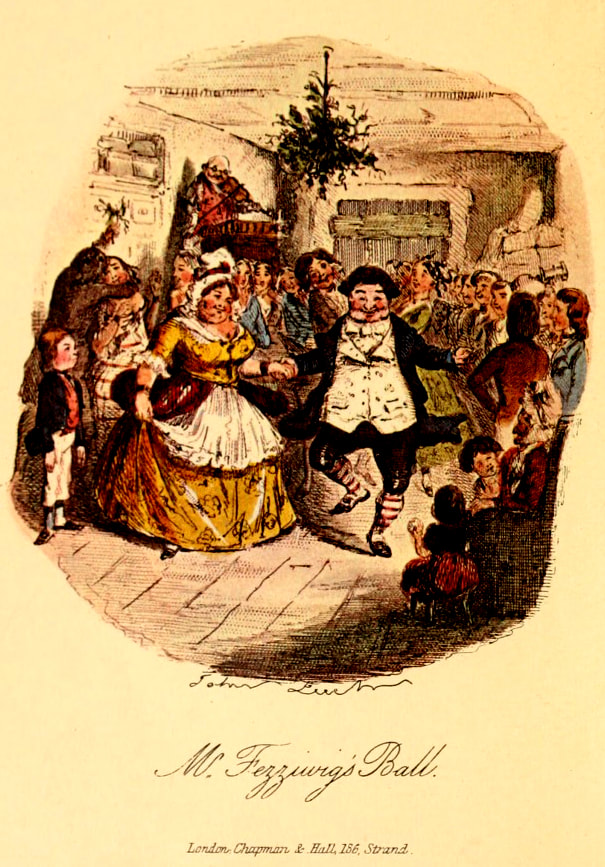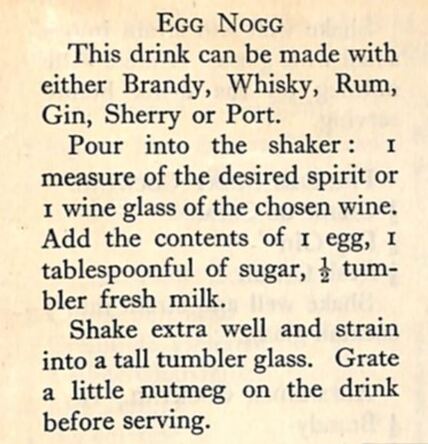|
Thanks to everyone who joined us for Episode 24 of the Food History Happy Hour! In this episode we made eggnog and talked about all things Christmas, including Medieval beverages, the origins of fruitcake, plum pudding, and mincemeat. Full list of historic Christmas beverages below, and here's a little more history on the Eggnog Riot of 1826 at West Point! We also talked briefly about Charles Dickens (hence the Fezziwig image!) and the 2017 movie "The Man Who Invented Christmas," which I recommend!
(Apologies for the fuzzy audio - not sure what happened!)
A LOT of historic recipes for eggnog call for party-sized portions. But there are lots of single-serve versions in vintage bartender's guides through the ages. I thought we would use this one, Practical Bar Management, by Eddie Clark, published in 1954, which, co-incidentally, is also the same year the movie White Christmas came out. If you'd like to catch up with the menu I put together to go along with White Christmas, you can see all the blog posts and recipes here.
Eggnog (1954)
As you can tell, this recipe isn't exactly exact! Not even the spelling. Here's the original text:
"This drink can be made with either Brandy, Whisky, Rum, Gin, Sherry, or Port. "Pour into the shaker: 1 measure of the desired spirit or 1 wine glass of the chosen wine. Add the contents of 1 egg, 1 tablespoonful of sugar, 1/2 tumbler fresh milk. "Shake extra well and strain into a tall tumbler glass. Grate a little nutmeg on the drink before serving." Here's my adaptation, which I shook over ice to make it cold, which I think watered things down a smidge. Still very good. 1 jigger spiced rum 1 pony bourbon 1 large egg, well-washed 1/2 cup whole milk 1 tablespoon sugar Shake very well until cold and frothy. Grate some fresh nutmeg on top and serve cold. I am not generally a fan of prepared eggnog you can buy in stores. It's usually thickened with carageenan, VERY sweet, and very strongly flavored. This homemade version was much nicer - not as thick (although you could use half and half or light cream instead of milk for a richer product and skip the ice), not nearly as sweet, and although the alcohol was very forward (you could cut back a bit if you want), it was quite nice - creamy with a frothy head and didn't taste much like eggs at all, surprisingly. I'm a fan! Holiday Beverage Glossary
A LOT of different holiday beverages came up in the comments, so I thought I'd list a few with approximate ages and places of origin.
So what do you think? Did I miss any historic holiday beverages? At our house, we always serve an 18th century punch called Second Horse Punch. Which, like most Christmas classics, needs to be made in advance! Do you have any special or traditional holiday beverages? Share in the comments!
Food History Happy Hour and the Food Historian blog are supported by patrons on Patreon! Join us for awesome members-only content like free digitized cookbooks from my personal collection, e-newsletter, and even snail mail from time to time!
0 Comments
Your comment will be posted after it is approved.
Leave a Reply. |
AuthorSarah Wassberg Johnson has an MA in Public History from the University at Albany and studies early 20th century food history. Archives
July 2024
Categories
All
|



 RSS Feed
RSS Feed